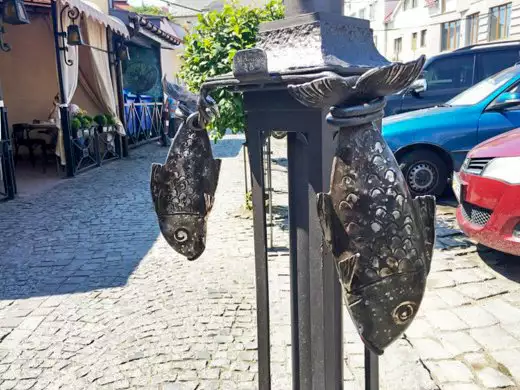🕒 Date of last update of the article: 13.02.2024 at 10:32 p.m | 🖋 Author: Viktor Shatrov
Надсилайте актуальну інформацію та отримуйте більше цільових клієнтів. Ми розмістимо ваш об’єкт у нашому каталозі та покажемо поруч із локаціями, а також у загальному каталозі, це безкоштовно!
🕒 Date of last update of the article: 13.02.2024 at 10:32 p.m | 🖋 Author: Viktor Shatrov
The mini-sculpture was unveiled on 7 February 2015. It became the thirteenth in Uzhgorod. The sculptural composition is made in the form of two metal fish on a pole. These two fish symbolise the Uzh River and its Small Uzh arm, and their shiny scales are a symbol of the sparkling river waves. This mini-masterpiece was installed on Fedynets Street near the Mustard Seed Lane (GPS: 48.625091, 22.298392). Historians believe that it was in this place that in 1930 they began to fill in the channel of the Small Uzh, which resulted in its disappearance.
The idea of the sculptor Mykhailo Kolodko was embodied in metal by the famous Uzhgorod blacksmith Vasyl Kryvanych. This time, the material for the sculpture was not bronze but stainless steel. According to Vasyl Kryvanych, the “stainless steel” for the sculpture was made using a special blacksmithing technology.

Content
| 🗺 Location | N48°37′31″ E22°17′53″ |
| 🗽 Opening date | 02/07/2015 |
| 🧑 Sculptor | Mykhailo Kolodko |
| 🧑 Blacksmith | Vasyl Kryvanych |
| 🧭 Distance from the center of Uzhgorod | Near |
| 🚙 Road for | Car, on foot |
| 🏕 Stop with a tent | No |
| 🏡 Housing nearby | Uzhgorod |
| ☕ Cafes and shops | Uzhgorod |
The current channel of the Uzh is partly artificial, having been dug in 1333. Few people know that until 1936 there was another “river” in the city – a tributary of the Uzh River called Small Uzh. It flowed in the area of Pidhradska and Fedynets streets and flowed into the Uzh near the modern Pushkin Square. From the 17th century until the 1930s, Small Uzh was an extremely important waterway in the city. It was home to an eight-grinder mill built in 1796. The second name of the Small Uzh, the Mlynskyi Canal, comes from this mill. Thanks to this waterway, the city became a trade centre of the region, as the river, together with the “big” Uzh, turned the Castle Hill into an island, making this part of the city and the castle inaccessible to enemies.
By 1936, the Small Uzh was completely placed underground in steel pipes with a diameter of 3 metres.
Nadiia Popadiuk tells an interesting legend about the mini-sculpture “Small Uzh” in her book “Uzhgorod – the World Capital of Mini-Sculptures”. According to this legend, the pipe in which the Small Uzh, a huge snake fish Uzhserpente, which used to live in the moat of Uzhgorod Castle, is still hiding, and now protects the city’s inhabitants from enemy attacks. A local sculptor has placed a mini-sculpture of Uzhserpente’s child fish as a reminder that if they get angry, they can break the water pipe of the Small Uzh and flood the city.
| 🔰 Start | From the mini-sculpture “Ukraine – One” |
| 🚶 Walking distance (through Dovzhenka Street and Fedyntsa Street) | 300 m |
| 🕒 Approximate time | 4 minutes |
| ⬆ Rise | Mostly without ups and downs |
Author of the article: Viktor Shatrov
Number of articles: 1100+
Knowledge of languages:: Ukrainian, English
Favourite quote: “Travelling – the only thing that makes you richer“
He was born and lived all his life in Uzhhorod. He graduated with a gold medal from Uzhhorod School No. 1 named after Taras Shevchenko (now Uzhhorod Lyceum named after Taras Shevchenko). He studied at the History Department of UzhNU, graduating with honours in 2009. He worked as a senior researcher at the Transcarpathian Museum of Folk Architecture and Life, a lecturer at the East European Slavic University.